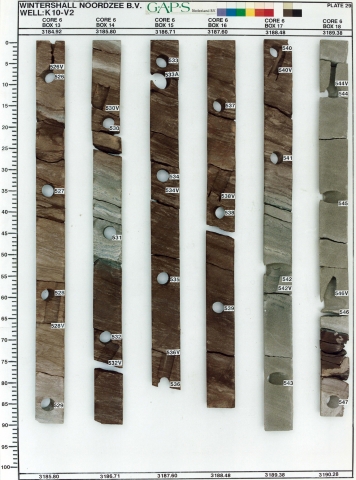Code
ROCLA
Status
Formal (Van Adrichem Boogaert 1976). Amended (NAM & RGD 1980) and (Van Adrichem Boogaert & Kouwe 1994).
Lithological description
Red-brown, sandy clay-and siltstone interval, with some intercalated sand-/siltstone stringers and beds. Anhydritic nodules can be common in the claystones of some intervals.
Depositional setting
Playa lake to mudflat.
Definition of lower boundary
Placed (going from top to base) at the top of the first definite sandstone bed of the Lower Slochteren Member.
Definition of upper boundary
Placed (going from top to base) at the base of the last definite sandstone bed of the Upper Slochteren Member.
Thickness indication
A highly variable thickness but with a trend of increasing thickness towards the North from its southern pinch-out line location. Generally less than 150 m, but up to 268 m in L08-H-02-S1.
Geographical distribution
Regional correlation
UK: Silverpit Formation; GER: Elbe Sub-Group; BEL: -.
Age
Capitanian - Wuchiapingian.
Holostratotype
Well:
Depth (thickness) AH:
3581.5 - 3628 m (46.5 m)
Hypostratotype
Depth (thickness) AH:
3041 - 3058 m (17 m)
Origin of name
Named after the Wadden island of Ameland.
Previous name(s)
None.
Reviewed by (date)
Harmen Mijnlieff (2017).
References
NAM & RGD 1980. Stratigraphic nomenclature of The Netherlands. Verhandelingen van het Koninklijk Nederlands Geologisch Mijnbouwkundig Genootschap 32, 77 p.
Van Adrichem Boogaert, H.A. & Kouwe, W.F.P. 1994. Stratigraphic nomenclature of The Netherlands; revision and update by RGD and NOGEPA, Section D, Permian. Mededelingen Rijks Geologische Dienst, 50, 1-42.
Van Adrichem Boogaert, H.A. 1976. Outline of the Rotliegend (Lower Permian) in The Netherlands. In: Falke, H. (ed.), The continental Permian in Central, West, and South Europe, 23-37.
Cite as
TNO-GDN ([YEAR]). Ameland Member. In: Stratigraphic Nomenclature of the Netherlands, TNO – Geological Survey of the Netherlands. Accessed on [DATE] from https://www.dinoloket.nl/en/stratigraphic-nomenclature/ameland-member.
